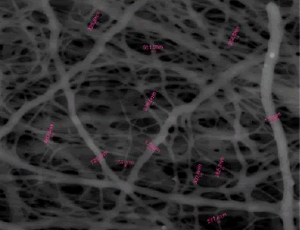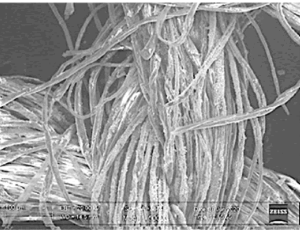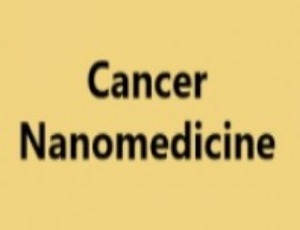Loading
Journal of Nanotechnology and Nanomaterials
ISSN: 2692-630X


Ahmed Mohammed Abu-Dief
Professor of Inorganic and Physical Chemistry at Chemistry Department
Oviedo University, Spain
Featured Article
Nanofibers Based on Concentrated Collagen Hydrolysate Loaded with Essential Oils

Featured Article
Rapid Inactivation of SARS-CoV-2 by Coupling Tungsten Trioxide (WO3) Photocatalyst with Copper Nanoclusters

Featured Article
Cancer Nanomedicine: Strategies to Enhance Tumor Delivery and Immunotherapy

About this Journal
Journal of Nanotechnology and Nanomaterials is a multidisciplinary journal that publishes high quality articles related to current advancements in nanoscience and nanotechnology. This interdisciplinary journal covers vast topics dealing with the involvement of nanosized materials in different phases of science and technology such as physics, chemistry, biology, sensors, computation, etc.
Articles
Functionalized Carbon Nano-onions for Polymer Composites
Functionalized CNOs can be tailored through chemical modifications to enhance their compatibility with various polymer matrices, a practice that has seen increasing utilization across diverse fields. This editorial article examines the role of these functionalized nanoparticles in revolutionizing polymer composites, specifying briefly the techniques for their functionalization, the general types of polymer matrices used, their effects on composite properties, and their broadening range of applications.
Cardiac Stents from Research to Clinical Applications
Early diagnosis and treatment of atherosclerosis are of vital importance in cardiology. Because of high risk and complexity of open-heart surgery, nowadays balloon angioplasty and stent implantation are common techniques to extend arterial vessels narrowed by atherosclerosis. Serious drawbacks of previous stents, such as complications induced by delayed healing and local hypersensitivity reactions and so re-narrowing and vascular reocclusion, have led to the development of stent designs, stent delivery systems, ultrasonic guidance of stent situation, and high-pressure dilatation post-stenting modifications [2-5].
Recent Advances in Different Nanoprecipitation Methods for Efficient Drug Loading and Controlled Release
Nanoprecipitation has emerged as a versatile and efficient technique for formulating nanoparticles, providing significant advantages in drug delivery applications. Nanomaterials, particularly polymer nanoparticles (PNPs), play a crucial role in encapsulating and controlling the release of drug molecules, serving as an alternative to traditional drug delivery methods. Various types and morphologies of PNPs have been synthesized using different nanoprecipitation methods that are being used as drug carriers, demonstrating superior performance in targeted drug delivery with controlled release compared to conventional methods.
Comment on “Cholesterol Induced Asymmetry in DOPC Bilayers Probed by AFM Force Spectroscopy”
In the recent article, Adhyapak et al., used Atomic Force Microscopy (AFM) and Force Spectroscopy to investigate the influence of cholesterol on the phase state behaviour of fluid phase DOPC membranes and found that the excess cholesterol conditions (above 20%) can induce an asymmetry in the lipid bilayer leading to changes both topography and more significantly in the nanomechanical properties of the lipid bilayer.
Nanoscale Diagnosis and Therapy: Nanotheranostics as an Advance in Nanotechnology
The term "nanotechnology," introduced in 1986, refers to the emergence of a novel technology poised to transform existing protocols at the nanoscale. For many years, publications regarding nanotechnology have generated significant expectations related to discoveries and solutions. In 1990, with the inception of green chemistry, the scientific community began to reassess its approach, inspired by adaptations of protocols established by various eco-friendly institutions.
Cutting-Edge Nanoparticle Innovations in Biomedical Science: Synthesis, Applications, Challenges, and Future Prospects
Nanoparticles (NPs), identified as particles measuring between 1 and 100 nanometers, exhibit distinct physical and chemical properties that set them apart from larger materials. These attributes, which encompass a substantial surface area relative to volume and quantum phenomena, render them highly across various sectors.
Development of Functional Nano-, Micro-Biostructures with Generation of New Enhanced Light Pathways for Life Science Applications
Life sciences involve a broad overview of fundamental research of high interest, accompanied by the development of applications based on emerging needs. The generation of non-classical light is a high-impact area of research that could lay the foundation for functional materials, particularly in applications requiring tracking and switchable (on/off) properties. In this regard, the present communication is intended to present and discuss how natural and synthetic bio-structures, along with Nanotechnology, could provide versatile platforms for developing functional and multi-functional structures accompanied by the generation of novel non-classical light pathways.
Weak Interactions in Catalysis
Traditional catalytic theory has predominantly centered on static chemical bond processes, specifically the weakening, breaking, strengthening, and formation of chemical bonds – representing relatively fixed patterns of transformation. Whereas the dynamic regulatory mechanisms of weak interactions have been relatively understudied. This paradigm shift emerges from recognizing how precisely engineered 3D spatial arrangements govern catalytic efficiency: directional hydrogen bonds, size-matched hydrophobic cavities, and π-π stacking at optimal distances collectively create confined microreactors that steer reaction pathways.
Enhancing p-type DSSC Performance through Nio-carbon Allotrope Hybrids: A Study of Functionalized MWCNT Integration
In this study, we systematically investigated the influence of various carbon allotropes on the photovoltaic performance of p-type dye-sensitized solar cells (DSSCs) using nickel oxide (NiO) nanotubes as the base semiconductor. The selected carbon nanostructures multi-walled carbon nanotubes (MWCNTs), reduced graphene oxide (RGO), graphene quantum dots (GQDs), and fullerenes (C60) were integrated with NiO and evaluated based on their structural and electrochemical characteristics.
Electrochemical Supercapacitors Based on Hydrous RuO2/oxidized Multi-walled Carbon Nanotube Composites
Electrochemical properties of ruthenium oxide (RuO2)/oxidized multi-walled carbon nanotube (MWCNT) (RuO2/MWCNT) composite electrodes in supercapacitors were investigated. The electrodes were prepared by impregnating MWCNTs with different concentrations of RuCl3•xH2O solution, followed by chemical reduction and annealing at 150°C under a nitrogen atmosphere.
Using Intralipid to Improve Delivery of Anti-Cancer Nanodrugs: Effects on RES Clearance and Toxi city, EPR, and Immune Modulation
Encapsulation of therapeutic molecules (e.g., small molecule inhibitors, mRNA, siRNA, aptamers, etc.) into nanomaterials can improve the solubility and blood circulation of the drugs, alter their biodistribution, decrease their toxicities, overcome drug resistance, and facilitate their entry into target cells. The development of anti-cancer nanodrugs has been the focus of intense study for decades. Several anti-cancer nanodrugs have been approved for clinical use all over the world.
Nanofibers Based on Concentrated Collagen Hydrolysate Loaded with Essential Oils
The manufacture of scaffolds for wound healing has become important, especially the formation of tissuespecific scaffolding. In order to create scaffolds, it is essential to mimic the chemical composition, physical morphology and biological functions of the human body. Scaffolds can be created by using synthetic polymers (e.g. polycaprolactone) or natural polymers (e.g. chitosan) or a combination of both. The addition of natural polymers can be very advantageous as they can avoid
Green Nanotechnology: The Influence of Intermolecular and Supramolecular Interactions
In the last decade, the study of nanometer-scale particles has grown exponentially worldwide. This growth is due to the broad field of nanostructures applications, which, due to their dimensions in nanometric sizes, have new properties not found in micro and macro scale. These properties result from the increase in the ratio between the surface area and volume, and the nanostructures’ size directly influences these. Tolerance to temperature, variety of colors, changes in chemical reactivity,
Cancer Nanomedicine: Strategies to Enhance Tumor Delivery and Immunotherapy
Cancer nanomedicine was originally developed for more efficient delivery of chemotherapeutic agents into tumor, and has been extensively employed as a therapeutic for cancer treatment owing to its unique features in drug delivery, diagnosis and imaging, as well as the therapeutic nature of some nanomaterials themselves.
Engineered Rh Nano-networks on DNA for SERS Applications
The study of surface and interfacial science via analytical techniques is a growing interest in the easy mode of diagnosing probe molecules adsorbed on the surface. In that line, Raman spectroscopy is an analytical method that is inefficient to carry the surface analysis employing their weak cross-sectional scattering until the discovery of Surface-Enhanced Raman Scattering (SERS) in late 1970s
Biological and Non-Conventional Synthesis of Zinc Oxide Nanoparticles (ZnO-NPs): Their Potential Applications
In nature, nanoparticles can be found as natural or synthetic. Nanoparticles may form either physically or chemically. Nanoparticles are uniform types of common material whose dimensions are less than 100 nm. Volcanic ash, ocean spray, fine sand, and dust are some examples of natural nanoparticles.
Photocatalytic Degradation of Organic Dyes Using Titanium Dioxide (TiO2) and Mg-TiO2 Nanoparticles
Titanium dioxide (TiO2 ) based nano-sized photocatalysts (NPCs) were synthesized following a green method from the extract of Peepal (Ficus religiosa) leaves and titanium tetrachloride as precursors. Doping of TiO2 with Magnesium (Mg) was done using magnesium chloride through the method of chemical precipitation. Size of the NPC samples were estimated and characterized by CPS Disc Centrifuge, Diffracted Light Scattering (DLS) and Field Emission Gun Scanning Electron Microscopy (FEG-SEM) techniques.
A Review on Nanotechnology: Applications in Food Industry, Future Opportunities, Challenges and Potential Risks
Nanotechnology is an evolving revolution with enormous promise in a variety of fields, including mechanics, medicine, and the food business. Nanoparticles owing to having greater surface area and enhanced rates of mass transfer seem to pose higher biological and chemical activities, penetrability, catalytic behaviour, enzymatic reactivity, and quantum
Nanotechnology for Water Purification – Current Trends and Challenges
Environmental pollution is a significant concern in both developing and developed countries. The pollution load in the environment accumulates as a result of anthropogenic activity. Both organic and inorganic contaminants are hazardous to living things, and their incidence and persistence have risen dramatically in current years.
Detection of Viruses and Development of New treatments: Insights into Antibody-Antigen Interactions and Multifunctional Lab-On-Particle for SARS CoV-2
The Corona Virus disease is a severe respiratory problem generated via severe acute respiratory syndrome coronavirus 2 (SARS CoV-2). The latest strain of the disease was deadly enough to halt the global routines of human development. In this context, a number of research studies have been conducted to provide knowledge and to combat with this severe illness.
Nanotechnology in Water Treatment: An Optimistic Perspective for the Near Future
Unequal access to drinking water and basic sanitation are old issues in Brazil and worldwide. Besides, this situation foments the proliferation of infectious parasitic diseases. Moreover, mainly in underdeveloped countries, it victimizes socioeconomically vulnerable people. The degree of water contamination analysis, usually by fecal matter, is made by the number of microorganisms present in the sample, including Escherichia coli or thermotolerant coliforms. In addition, several
Biosynthesis of Manganese Dioxide Nanoparticles and Optimization of Reaction Variables
Biosynthesis is an efficient and environmentally friendly process used to synthesize nanoparticles. This study presents a simple, environmentally friendly, and cost-effective method for synthesizing manganese dioxide nanoparticles from aqueous manganese (II) acetate using lemon extract as a reducing agent. Turmeric extract (curcumin) was employed to stabilize the biosynthesized nanoparticles. UV-visible spectroscopy was used to evaluate the concentration of nanoparticles at 350 nm wavelength.
The Effect of Nano-Encapsulated Orlistat on Prostate Cancer: An In vitro Study
Background: The targeted inhibition of fatty acid synthase (FASN) by Orlistat, a potent FASN inhibitor, has been shown to block tumor proliferation and induce apoptosis in cultured tumor cells. Since Orlistat is insoluble, its solubility in blood circulation is limited. Cancer nanotherapeutics are rapidly progressing and are being implemented to solve several limitations of conventional drug delivery systems.
How to Compare and Select Flame Retardants for Rigid Polyurethane Foam
Polyurethane (PU) foam is synthesised via a polymerisation reaction of polyol and isocyanate, in the presence of various formulations of catalysts and surfactants. For this reason, depending on the composition, PU foam can be tailor-made into flexible foams, semi-rigid foams, and/or rigid foams, resulting in a wide range of products with unique properties.
Nanotechnology for Water Purification – Current Trends and Challenges
Environmental pollution is a significant concern in both developing and developed countries. The pollution load in the environment accumulates as a result of anthropogenic activity. Both organic and inorganic contaminants are hazardous to living things, and their incidence and persistence have risen dramatically in current years.
Green Nanotechnology: The Influence of Intermolecular and Supramolecular Interactions
In the last decade, the study of nanometer-scale particles has grown exponentially worldwide. This growth is due to the broad field of nanostructures applications, which, due to their dimensions in nanometric sizes, have new properties not found in micro and macro scale. These properties result from the increase in the ratio between the surface area and volume, and the nanostructures’ size directly influences these. Tolerance to temperature, variety of colors, changes in chemical reactivity,
Multidirectional Benefits of Nanotechnology in the Diagnosis, Treatment and Prevention of Tuberculosis
Despite the curious advancement in medical science and therapeutics, tuberculosis (TB) persist the primary factor of mortality than any other infectious disease and socioeconomic disaster for millions of people around the world. According to the World Health Organization (WHO), World’s One-third of the population is infected with this disease and of these, 8 to 10 million people develop active disease and 2 million people die each year and the rest of the infected people remain asymptomatic.
About Scientific Archives
Scientific Archives is a global publisher initiated with the mission of ensuring equal opportunity for accessing science to research community all over the world. Spreading research findings with great relevance to all channels without any barrier is our goal. We want to overcome the challenges of Open Access with ensured quality and transparency.
